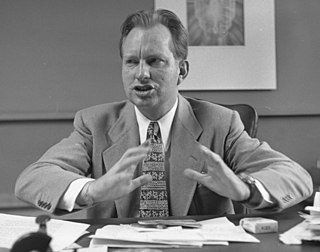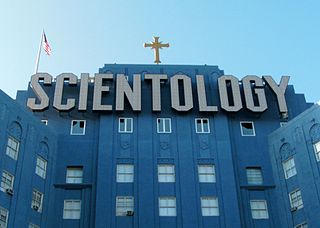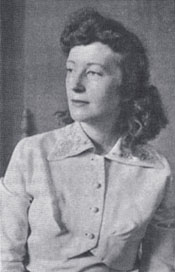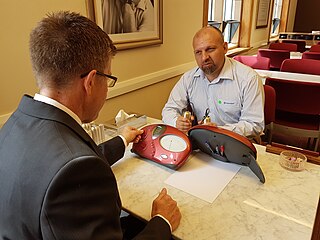
Dianetics is a set of ideas and practices, invented in 1950 by science fiction writer L. Ron Hubbard, regarding the human mind. Dianetics was originally conceived as a form of psychological treatment, but was rejected by the psychological and medical establishments as pseudoscientific. It was the precursor to Scientology and has since been incorporated into it. It involves a process referred to as "auditing", which utilizes an electrical resistance meter, ostensibly to remove emotional burdens and "cure" people from their troubles.

Lafayette Ronald Hubbard was an American author and the founder of Scientology. A prolific writer of pulp science fiction and fantasy novels in his early career, in 1950 he authored Dianetics: The Modern Science of Mental Health and established organizations to promote and practice Dianetics techniques. Hubbard created Scientology in 1952 after losing the intellectual rights to his literature on Dianetics in bankruptcy. He would lead the Church of Scientology – variously described as a cult, a new religious movement, or a business – until his death in 1986.

Free Zone, Freezone, and Independent Scientology are umbrella terms for the groups, organizations, and individuals who practice Scientology beliefs and practices independently of the Church of Scientology (COS). Such practitioners range from those who closely adhere to the original teachings of Scientology's founder L. Ron Hubbard, to those who have adapted practices far from COS beliefs and practices.

Followers of the Scientology movement maintain a wide variety of beliefs and practices. The core belief holds that a human is an immortal, spiritual being (thetan) that is resident in a physical body. The thetan has had innumerable past lives, some of which, preceding the thetan's arrival on Earth, were lived in extraterrestrial cultures. Based on case studies at advanced levels, it is predicted that any Scientologist undergoing auditing will eventually come across and recount a common series of past-life events.

Mary Sue Hubbard was the third wife of L. Ron Hubbard, from 1952 until his death in 1986. She was a leading figure in Scientology for much of her life. The Hubbards had four children: Diana, Quentin (1954–1976), Suzette, and Arthur.

The E-Meter is an electronic device used in Scientology that allegedly "registers emotional reactions". After claims by L. Ron Hubbard that the procedures of auditing, which used the E-Meter, could help heal diseases, the E-Meter became the subject of litigation. Since then, the Church of Scientology publishes disclaimers declaring that the E-Meter "by itself does nothing", is incapable of improving health, and is used solely for spiritual purposes.

In Scientology, Operating Thetan (OT) is a state of complete spiritual freedom in which one is a "willing and knowing cause over life, thought, matter, energy, space and time". The Church of Scientology offers eight "levels" of OT, each level costing thousands of US dollars. Each OT level is confidential and is not revealed to anyone beforehand. In summary, the objective of these levels is to remove "body thetans" which are "confused, disembodied souls from other planets who have attached themselves to us".

Auditing, also known as processing, is the core practice of Scientology. Scientologists believe that the role of auditing is to improve a person's abilities and to reduce or eliminate their neuroses. The Scientologist is asked questions about past events while holding two metal cylinders attached to an electrical resistance meter (galvanometer) with a dial. The term "auditing" was coined by L. Ron Hubbard in his 1950 book Dianetics: The Modern Science of Mental Health, which describes the process.

The term fair game is used to describe policies and practices carried out by the Church of Scientology towards people and groups it perceives as its enemies. Founder of Scientology L. Ron Hubbard established the policy in the 1950s in response to criticism both from within and outside his organization. Individuals or groups who are "fair game" are judged to be a threat to the Church and, according to the policy, can be punished and harassed using any and all means possible. In 1968, Hubbard officially canceled use of the term "fair game" because of negative public relations it caused, although the Church's aggressive response to criticism continued.
In Dianetics and Scientology, Clear is a status afforded to followers by the Scientology organization, or by other Scientologists, after they complete certain activities. It is one of the major ostensible "states" practitioners strive to reach on their way up what the Scientologists call the Bridge to Total Freedom. Scientology followers are given the status of Clear when a person is deemed to be free of the influence of engrams – supposed unwanted emotions or painful traumas which Scientology claims are not readily available to the conscious mind. Scientologists believe that human beings accumulate anxieties, psychosomatic illnesses, and aberration due to receiving engrams throughout their current or past lives, and that by applying Dianetics, every single person can obtain the status of Clear.

Scientology ethics and justice are a collection of policies and procedures by L. Ron Hubbard and used by the Church of Scientology. Scientology defines ethics as "the actions an individual takes on himself", and justice as "the action taken on the individual by the group when he fails to take these actions himself". The body of writings include techniques and policies of moral choices, and the rules of conduct to be followed by scientologists.
When the individual fails to put in his own ethics, the group takes action against him and this is called justice.

Scientology: A History of Man is a book by L. Ron Hubbard, first published in 1952 under the title What to Audit by the Scientific Press of Phoenix. According to the author, it provides "a coldblooded and factual account of your last sixty trillion years." It has gone through many editions since its first publication and is a key text of the Church of Scientology. The book has been ridiculed by critics of Scientology for its unusual writing style and pseudoscientific claims; it has been described as "a slim pretense at scientific method ... blended with a strange amalgam of psychotherapy, mysticism and pure science fiction; mainly the latter."
Practices in Scientology make extensive use of techniques drawn from hypnosis. They are used in 'auditing' and in the Training Routines widely practiced within the Church of Scientology. Hypnosis, in this context, is defined as language and nonverbal communication employed to induce heightened responsiveness and suggestibility. The Church of Scientology denies that its practices involve hypnosis. The organization says that it will not permit individuals who say they have previously experienced hypnosis – as either a subject or practitioner – to participate in Scientology training, with the stated reasoning that there is a possibility of harm caused by the prior exposure to hypnosis.

This bibliography of Scientology includes Scientology and Dianetics-related books, periodicals and other issues authored by L. Ron Hubbard and those produced by the Church of Scientology and its related organizations. Books bearing L. Ron Hubbard's name are considered texts of Scientology's canon.
The amount of material on Dianetics and Scientology is extensive, to say the least. This material is composed of books by L. Ron Hubbard ; compilations of his works; taped lectures; auditor training materials ; course packages; booklets; a large number of magazines and annuals; and video recordings of the major annual events.

The Bridge to Total Freedom, also known as the Classification, Gradation and Awareness Chart, is Scientology's primary action plan and road map to guide a person through the sequential steps to attain Scientology's concept of spiritual freedom. Displayed in every Scientology organization as an enormous poster using red ink, the comprehensive chart contains almost every service available within Scientology. Each step on the Bridge has a monetary cost.

The training routines (TR) are training exercises or drills used in the Church of Scientology as well as affiliated programs Narconon, Criminon, WISE, and Applied Scholastics. The church describes them as a way of learning to communicate effectively and to control situations. Some critics and former Scientologists claim the training routines have a strong hypnotic effect, causing hallucinations and an out-of-body experience known in Scientology as "exteriorization".
The Training Routines that are part of early Scientology indoctrination have been compared to acting exercises: students are taught to "duplicate," or mirror, a partner's actions; project their "intention," or thoughts, onto inanimate objects; experiment with vocal tones, the most dominant being a commanding bark known as "tone 40"; and deepen their ability to "be in their bodies" without reacting to outside stimuli.

The intersection of Scientology and abortion has a controversial history which began with Scientology founder L. Ron Hubbard's discussion of abortion in his 1950 book Dianetics: The Modern Science of Mental Health. Hubbard wrote in Dianetics that abortion and attempts at abortion could cause trauma to the fetus and to the mother in both spiritual and physical ways. Scientologists came to believe that attempted abortions could cause traumatic experiences felt by the fetus, which would later be remembered as memories referred to in Scientology as "engrams". In the Scientology technique called Auditing, Scientologists are frequently queried regarding their sexual feelings and behaviors. These questions about Scientologists' sexual behavior are often posed to members during "security checks", a specific form of auditing sessions where individuals are required to document their divergence from the organization's ethics. One of the questions asked in these security checks is, "Have you ever been involved in an abortion?".

Scientology is in part derived from, and shares elements with, a number of esoteric or occult systems. The extent of the influence of specific occult belief systems on Scientology is a subject of debate amongst scholars.
From 1953 to 1967, L. Ron Hubbard was the official leader of the Church of Scientology.









